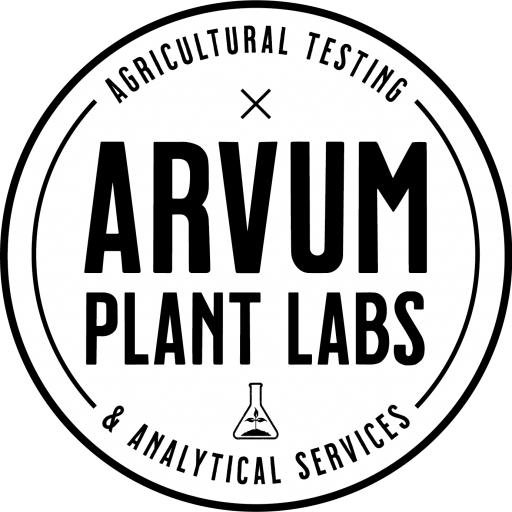
Agricultural Testing & Analytics
SAMPLING PROCEDURES
SOIL MEDIA
Soil test results for pH, organic matter, phosphorous and potassium (routine test) can be useful for correlating with plant analysis results to pinpoint a nutrient problem. A composite soil sample, consisting of 3 to 5 cores, taken to a depth of 6-7 inches of outdoor soil samples or half the depth of the container for potted plants, should be taken from the same area where the plant sample was collected.

TESTING WHAT
Samples should not be taken from plants that obviously have been stressed from causes
other than nutrients. Do not take samples from plants that —
· Are dead or insect damaged;
· Are mechanically or chemically injured;
· Have been stressed by too much or too little moisture (i.e., flooding or drought)Soil test results for pH, organic matter, phosphorus, and potassium (routine test) can be useful for correlating with plant analysis results to pinpoint a nutrient problem. A composite soil sample, consisting of 3-5 cores, taken to a depth of 6-7 inches for outdoor soil samples or half the depth of the container for potted plants, should be taken from the same area where the plant sample was collected.
other than nutrients. Do not take samples from plants that —
· Are dead or insect damaged;
· Are mechanically or chemically injured;
· Have been stressed by too much or too little moisture (i.e., flooding or drought)Soil test results for pH, organic matter, phosphorus, and potassium (routine test) can be useful for correlating with plant analysis results to pinpoint a nutrient problem. A composite soil sample, consisting of 3-5 cores, taken to a depth of 6-7 inches for outdoor soil samples or half the depth of the container for potted plants, should be taken from the same area where the plant sample was collected.
Sample Collection
· Between 3-5 containers should be sampled and compiled into a single sample for submission.
· Samples should be collected on a per strain basis.
· Samples from healthy plants should be gathered as a single sample.
· Soil samples from sick or unhealthy samples should be sampled individually and documented
accordingly on the corresponding sample bags.
· When submitting soil samples for sick or unhealthy plants it is suggested to provide soil samples from healthy plants as well. (This is key in comparing analytical values and may immediately provide a clue to the issue.) Samples should not be taken from plants that obviously have been stressed from causes
other than nutrients. Do not take samples from plants that —
· Are dead or insect damaged;
· Are mechanically or chemically injured;
· Have been stressed by too much or too little moisture (i.e., flooding or drought)
· Samples should be collected on a per strain basis.
· Samples from healthy plants should be gathered as a single sample.
· Soil samples from sick or unhealthy samples should be sampled individually and documented
accordingly on the corresponding sample bags.
· When submitting soil samples for sick or unhealthy plants it is suggested to provide soil samples from healthy plants as well. (This is key in comparing analytical values and may immediately provide a clue to the issue.) Samples should not be taken from plants that obviously have been stressed from causes
other than nutrients. Do not take samples from plants that —
· Are dead or insect damaged;
· Are mechanically or chemically injured;
· Have been stressed by too much or too little moisture (i.e., flooding or drought)
TESTING WHERE
Outdoor Soil
· Samples should be taken to a depth of 6-7 inches.
Potting Media
· Samples should be taken from the top one-third of the pot excluding the first two inches.
Do Not Include
Remove any large wood chips or roots from the sample. This can provide inaccurate data.
Samples should not be taken from plants that obviously have been stressed from causes
other than nutrients. Do not take samples from plants that —
· Are dead or insect damaged;
· Are mechanically or chemically injured;
· Have been stressed by too much or too little moisture (i.e., flooding or drought)
· Samples should be taken to a depth of 6-7 inches.
Potting Media
· Samples should be taken from the top one-third of the pot excluding the first two inches.
Do Not Include
Remove any large wood chips or roots from the sample. This can provide inaccurate data.
Samples should not be taken from plants that obviously have been stressed from causes
other than nutrients. Do not take samples from plants that —
· Are dead or insect damaged;
· Are mechanically or chemically injured;
· Have been stressed by too much or too little moisture (i.e., flooding or drought)
TESTING FOR
Essential nutrients
pH, salinity, types and concentrations of soluble salts (calcium, magnesium, chloride, sodium, sulfate, phosphate, boron, and nitrate) in saturation extract, SAR, all essential nutrients, percent moisture, half saturation and 14 non-essential, potentially toxic trace minerals.
pH, salinity, types and concentrations of soluble salts (calcium, magnesium, chloride, sodium, sulfate, phosphate, boron, and nitrate) in saturation extract, SAR, all essential nutrients, percent moisture, half saturation and 14 non-essential, potentially toxic trace minerals.
Non-Essential nutrients – boron, calcium, chloride, copper, iron, magnesium, manganese, molybdenum, nitrogen, nickel, phosphorus, potassium, sulfur, zinc and for some plants sodium.
Non-Essential minerals – aluminum, arsenic, barium, cadmium, chromium, cobalt, lead, lithium, mercury, selenium, silver, sodium, strontium, tin, titanium, and vanadium.

